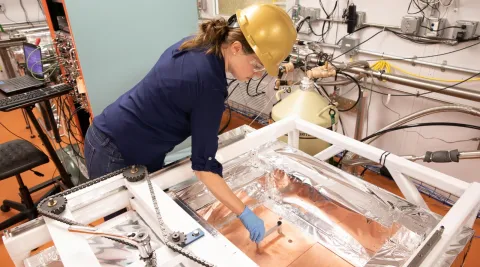SURF, South Dakota Mines to host international workshop on Low Radioactivity Techniques
Press release media

Dr. Brianna Mount works on a low-background counter in the Black Hills State University Underground Campus (BHUC) at Sanford Underground Research Facility.
Photo by Matthew Kapust
LEAD, SD— The Sanford Underground Research Facility (SURF) and South Dakota Mines (Mines) will cohost the Low Radioactivity Techniques (LRT) workshop series from June 14 through 17. The workshop will bring experts from across the globe to share information about this critical branch of particle physics research.
“SURF is thrilled to be co-hosting the international workshop on Low Radioactivity Techniques, as this is an important workshop for low-background community that SURF serves,” said Jaret Heise, science director at SURF
“The LRT workshop brings together the world’s experts in achieving the low levels of radioactivity needed for many cutting-edge applications in physics,” said Richard Schnee, professor and head of physics at Mines. “We are proud to be cohosting the workshop this year with SURF at South Dakota Mines, and we are looking forward to sharing some of the exciting work both on campus and at SURF.”
The LRT workshop will examine topics in low-radioactivity materials and techniques—topics that are fundamental to quantum information sciences and rare-event searches, including dark matter, solar neutrinos, double-beta decay, long half-life phenomena and nuclear astrophysics.
Researchers conducting rare-event searches often build their experiments deep underground in “quiet” spaces like SURF, away from cosmic rays produced by the Sun. But sometimes, going underground isn’t enough. Rare-event searches don’t just need to be shielded from cosmic rays—they also require low-radioactivity materials. That’s because even the tiniest amounts of radioactive elements in the materials used to construct experiments can obscure the signals researchers seek to detect. And with every advancement in low-radioactivity techniques, researchers get a clearer, quieter picture of the subatomic world.
This LRT workshop, the first since 2019, will feature the latest updates from underground laboratories around the globe on low-background detectors, techniques and assay programs, as well as recent developments in advanced machining and 3D printing using ultra-pure materials.
By bringing together experts in the field for presentations and discussion, the LRT workshop will foster collaboration and resource sharing to advance the development of new generations of detectors at underground facilities.
“Work showcased at the LRT workshop describes how current experiments are able to reach their sensitivity goals, while at the same time lighting the path for the next generation of experiments,” Heise said. “Not only is it exciting to learn about progress since the last LRT workshop, but we have the opportunity to show off SURF’s underground facilities to our friends and colleagues from around the world.”
Low-radioactivity techniques are vitally important to the mission of SURF, which hosts the United States’ deepest low-background counting facility, the Black Hills State University Underground Campus (BHUC). The BHUC screens materials for rare-event searches, ensuring only the most radio-pure materials are used in experiment assembly. SURF also hosts multiple rare-event search experiments, such as the LUX-ZEPLIN dark matter experiment, the Majorana Demonstrator and detectors for Fermilab’s Deep Underground Neutrino Experiment, which aim to develop low-background technologies and achieve world-leading sensitivities.
Mines, with a leading physics graduate program and strong research partnerships at SURF, is also invested in the advancement of low-radioactivity techniques. Mines researchers are among the world leaders in this important branch of physics. They are pioneering new methods to both assay radioactive background levels and reduce radioactive interference in key experiments at SURF and in other locations around the world.
Initiated by the Sudbury Neutrino Observatory in 2004, the 2022 LRT meeting is the eighth international workshop in the LRT series. Previous workshops have been hosted in Canada, France, Italy, US, South Korea and Spain.
Sanford Underground Research Facility is operated by the South Dakota Science and Technology Authority (SDSTA) with funding from the Department of Energy’s Office of Science. Our mission is to advance world class science and inspire learning across generations. Visit SURF at www.sanfordlab.org.
Founded in 1885, South Dakota Mines is one of the nation’s leading engineering, science and technology universities. South Dakota Mines offers bachelor’s, master’s and doctoral degrees and a best-in-class education at an affordable price. The university enrolls 2,418 students with an average class size of 24. The South Dakota Mines placement rate for graduates is 97 percent, with an average starting salary of more than $66,150. For these reasons College Factual ranks South Dakota Mines the #1 Engineering School for Return on Investment. Find us online at www.sdsmt.edu and on Facebook, Twitter, LinkedIn, Instagram and Snapchat.